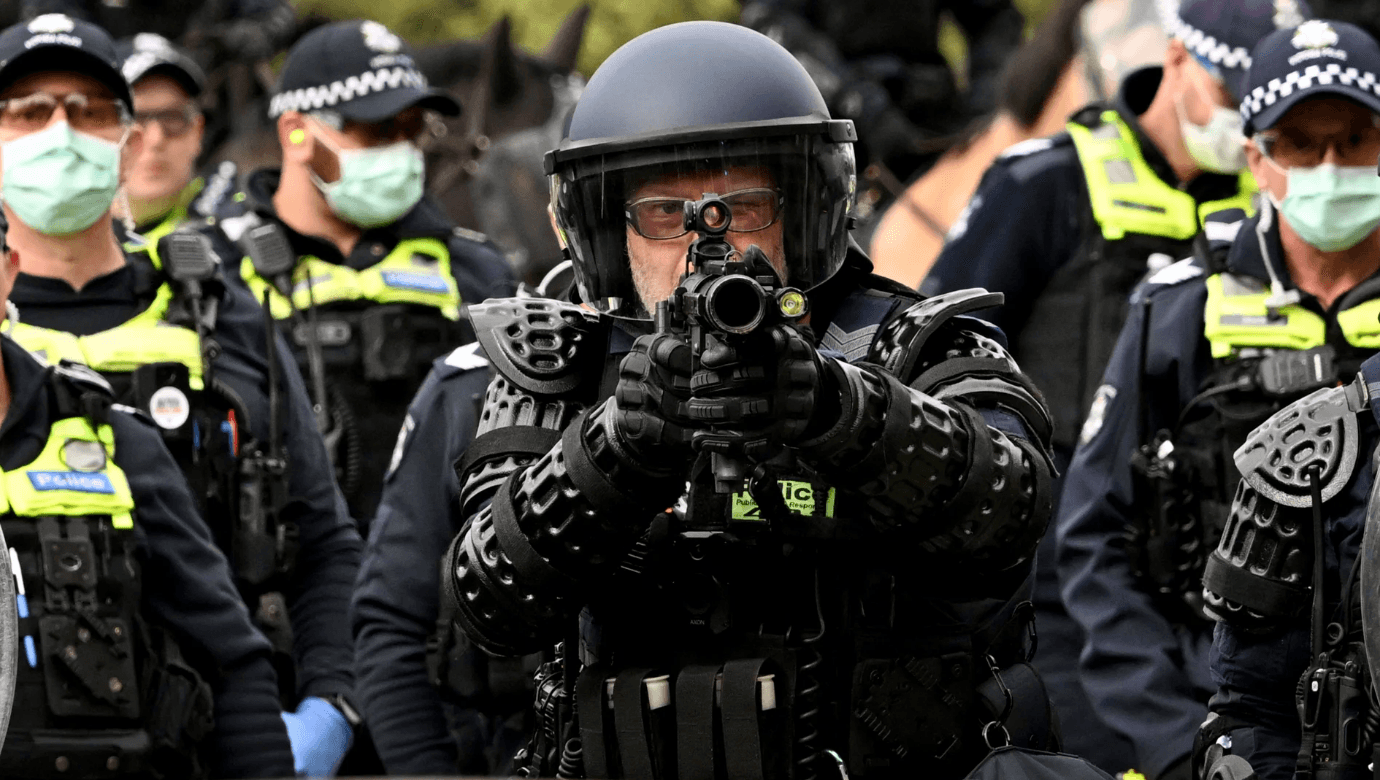Leaked: Victorian Labor’s planned anti-protest laws

Victoria’s Labor government is considering a suite of new anti-protest laws, according to a discussion document being circulated by the Department of Justice and Community Safety. The consultation paper, “Reforms to Victoria’s Protest Laws”, outlines potential new offences, including mask wearing and using “lock-on” devices.
The right to protest is a fundamental aspect of a democratic society. Governments and corporations across the world are trying to bomb and starve the Palestinians into oblivion—and they want to do it without public opposition. They pillage our natural environment, support police violence and drive up the cost of living. The only real power that working-class people have is our ability to strike, protest and disrupt business as usual.
Proposals that restrict the rights of people attending demonstrations must be rejected out of hand.
Masks
The paper suggests an all-out ban on “face coverings” at demonstrations, with potential exceptions for those who can be proven to be wearing them for religious or health reasons. The proposed punishment is a fine of up to ten penalty units—nearly $2,000. The document points out that this would be a first: “no jurisdiction in Australia has passed laws to create an express prohibition against the wearing of face coverings during a protest”.
It would create a different law for people exercising their democratic right to protest compared to people out shopping or partying, for example.
People’s right to wear masks ought to be defended—whether it be to help prevent the spread of infectious diseases, to protect themselves from capsicum spray or tear gas, or to hide their identity from the state.
Capsicum spray is an excruciating chemical weapon that causes temporary blindness, and Victoria Police use it widely and with impunity. Last year, the Independent Broad-based Anti-corruption Commission found that Victoria Police have repeatedly deployed it beyond its legally defined use. We need to be able to protect ourselves from such police assaults.
People should also be able to protest without having to reveal their identities. It is important for individuals involved in campaigns and movements to associate with their cause publicly. But this shouldn’t be a legal requirement. If it were, the right to protest against the government would exist only if the state knew who you were. With modern surveillance technology, this is akin to making it mandatory for protesters to hand in their driver’s licences before attending a rally.
Lock-on devices
The proposal to ban attachment devices like pipes and chains used as part of lock-on protests is also objectionable. These tools are classic symbols of non-violent protest. Today, they are mainly used in the environmental movement by activists risking their own safety to defend our planet from destruction.
The tactic was important in the 2014 campaign that saved the Manning Valley from fracking. Under the proposed laws, a person could face a fine of 120 penalty units or up to one year of imprisonment if they use the device in a public space and intend to “hinder, obstruct or interfere with a public place or the conduct of a business”. The proposal would also give police the right to search for an attachment device without a warrant.
Just two years ago, former Labor Prime Minister Julia Gillard attended the unveiling of a bronze statue of Communist Party member Zelda D’Aprano at the Victorian Trades Hall. The statue is complete with a bronze chain, which D’Aprano used to lock herself to the doors of the Commonwealth Building in 1969 to demand equal pay for women. If these proposals are adopted, her celebrated non-violent act would be a punishable offence.
Terrorist symbols
Another proposal is to outlaw the display of “terrorist symbols”. But again, the state decides which organisations, and therefore which symbols, are to be designated “terrorist”. This is almost always a political decision, and often based on the government’s international alliances, rather than genuine consideration of the group or symbol in question.
For example, along with many other legitimate national liberation organisations, the US Department of Defense designated the African National Congress as a terrorist group in the 1980s. It wasn’t until 2008 that the United States removed ANC leader and South Africa’s first post-apartheid president, Nelson Mandela, from its terrorism watch-lists—well after he had retired from public life.
The point here is that governments and states have overt political biases, which should, in most cases, disqualify them from being the arbiters of whether people can identify publicly with a political tendency or group.
Anti-democratic attacks on the right to demonstrate
Over the last decade, the prevailing government framework has been that protests ought to be treated as a form of violent crime.
Victorian governments have invested billions into heavily arming and expanding the police force. The cops now have pepper-ball rounds, flash bang grenades, pepper spray and special armoured divisions that are used against protesters.
In 2017, Labor extended police stop and search powers to users of public spaces and required people to remove face coverings in areas declared “designated zones”. It introduced new offences aimed at those who commit violence in public areas.
These laws have been used to target and punish protesters. The charge of “affray” has been brought against both those accused of participating in a machete-wielding brawl in a Melbourne shopping centre and protesters opposing a weapons convention last year. While they have been used against demonstrators in all sorts of situations, those laws claimed to target violence and were not specifically about protests. The new proposals would directly target protesters.
This conflation of “protester” with “criminal”, already implicit but made almost explicit with these new proposals, should be rejected by all those who support the democratic right to demonstrate. It’s a highly concerning development that laws are being drafted to punish certain aspects of non-violent protesting.
Make no mistake: these proposals are intended to target those who protest against war, racism and the climate crisis. They must be opposed.